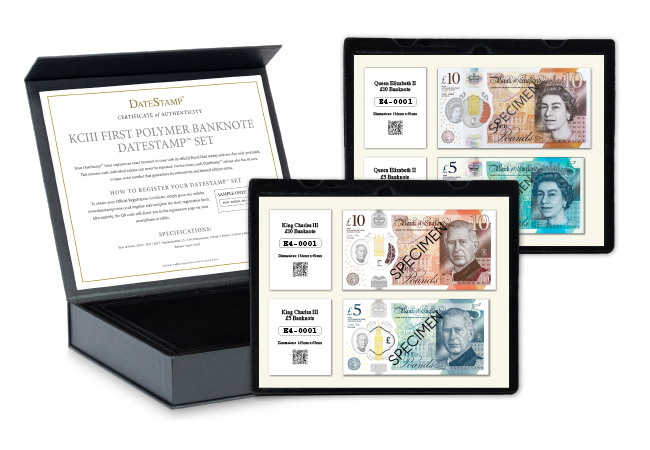Shop
CLOSER LOOK: The history-making vehicles that inspired an impressive set of 50ps…
This year, we’re celebrating 120 years of thrilling competition and daredevil feats with the NEW Isle of Man History of Motor Racing 50p Set.
We travelled to The National Motor Museum in Beaulieu where we met Patrick Collins – Curator: Vehicles and Research – who gave us a closer look at the history-making vehicles that inspired these impressive 50ps…
Watch our video below:
The Isle of Man Motor Racing 50p Set
Available exclusively from The Westminster Collection, this new 50p Set celebrates FIVE Motor Racing FIRSTS with each design featuring an iconic vehicle from history.
1904 – The FIRST Motor Race
The first motor race held on the Isle of Man decided Britain’s representatives for the Gordon Bennett Cup, marking the dawn of competitive Manx Motor Racing. Walter Thomas Clifford triumphed, covering the gruelling 255-mile course in 7 hours and 26 minutes in his Napier.
1907 – The FIRST Isle of Man TT Race
Fast forward to 1907, and we arrive at the birth of an iconic event – The first TT (Tourist Trophy) Race which was won by Rem Fowler on a Norton. This world-famous motorcycle race is synonymous with the Isle of Man and has been celebrated on a series of Isle of Man £2 Coins too!
1923 – The FIRST TT Sidecar Race
1923 was a landmark year for Manx Motorsports. First, the TT Sidecar Race was introduced – adding an extra layer of excitement to the race. The first Sidecar race was won by Freddie Dixon and passenger Walter Denney, who rode a Douglas to victory.
1923 – The FIRST Manx Grand Prix
1923 also marked the inaugural Manx Grand Prix. Known as the amateur’s alternative to the TT, the first Grand Prix was won by Len Randles on his 500cc Sunbeam.
1963 – The FIRST Manx Rally
Rounding out this extraordinary set is the coin celebrating the first Manx Rally in 1963. This landmark event was won by Reg McBride and Don Barrow in a Ford Anglia Allardette.
Available Exclusively from The Westminster Collection
You can view the Complete Isle of Man Motor Racing 50p Range on The Westminster Collection website. Prices start from JUST £37.50 and I’ve already seen SELL OUTS.

The Evolution of UK Banknotes: From Paper to Precision
The history of banknotes in the United Kingdom is a fascinating journey of innovation, security, and tradition. From the earliest issues to the forthcoming King Charles III banknotes, each phase reflects the technological and cultural shifts of its time.
A Brief History of UK Banknotes
The Bank of England began issuing banknotes shortly after its establishment in 1694. Initially, these notes were handwritten, a far cry from the highly sophisticated currency we use today. By the mid-18th century, partially printed notes were introduced, with the denomination and other details filled in by hand.
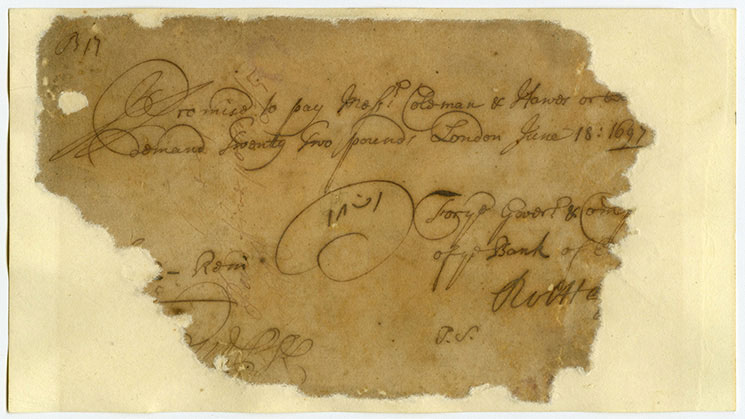
Source: Bank of England website
https://www.bankofengland.co.uk/museum/online-collections/blog/our-earliest-bank-of-england-note
The 19th century brought significant changes with fully printed notes and the introduction of standardized designs to prevent forgery. A pivotal moment in the history of UK banknotes came in 1960 when Queen Elizabeth II became the first monarch to be featured on the Bank of England notes. Her portrait on the £1 note marked the beginning of a tradition of depicting reigning monarchs on the nation’s currency, providing a sense of continuity and national identity.
Security Features: From Simplicity to Sophistication
As technology advanced, so did the sophistication of banknote security features. Early notes relied heavily on the quality of the paper and intricate designs to deter counterfeiters. However, as counterfeiting techniques improved, so too did the security measures.
Modern UK banknotes are a marvel of technology and design. Click on the dots below to explore the key security features:
Introducing the King Charles III Banknotes
In a historic move, the Bank of England is set to release the new King Charles III banknotes on June 5th, 2024. This marks the first time in over 70 years that a new monarch’s portrait will grace the currency, following the reign of Queen Elizabeth II.
The King Charles III banknotes will continue to feature the same high-security features of their predecessors and the new banknotes will initially be available in £5, £10, £20, and £50 denominations. They will circulate alongside the existing Queen Elizabeth II notes, gradually phasing out the older series as they wear out.
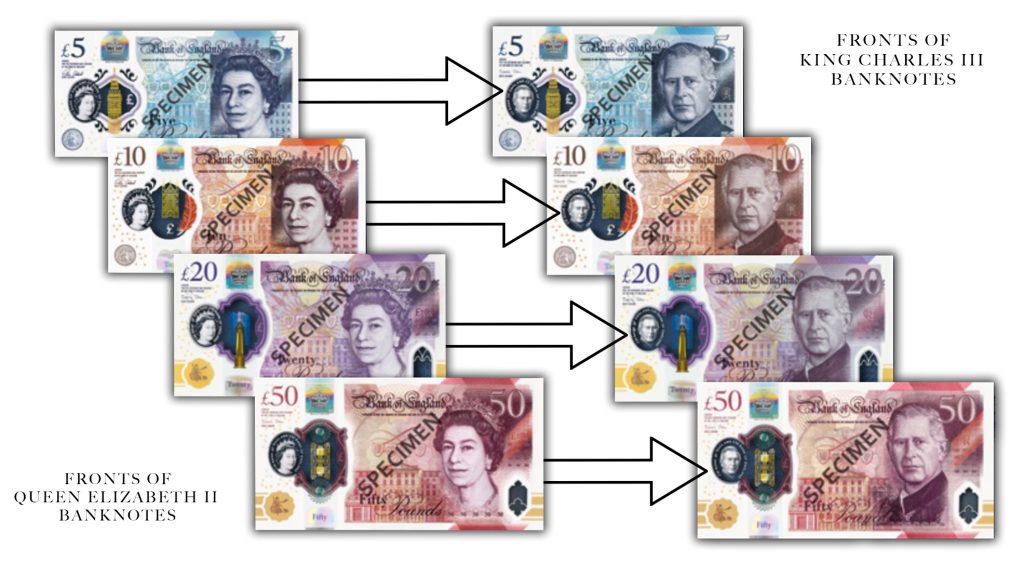
Introducing the DateStamp™ Set: Connecting the Past and Present
To commemorate this historic transition, we are excited to introduce an exclusive DateStamp™ set that brings together the past and the present of UK currency. This unique collection features the Queen Elizabeth II £5 and £10 banknotes alongside the brand new King Charles III £5 and £10 banknotes, each postmarked on the official issue date, 5th June, 2024.
You can now be one of just 2,024 collectors to own this special set.
Click here now to pre-order yours before the official release >>
The never-before-seen set of Branch Mint Sovereigns
Branch Mint Sovereigns are a captivating chapter in the world of numismatics, offering an enchanting glimpse into the rich history of gold coinage and the economic influence that spread across the British Empire and beyond. These coins, minted in locations outside the primary mint (the Royal Mint in London), played pivotal roles in the economies of their respective regions.
This blog will take you on a journey through the history, significance, and key dates of Branch Mint Sovereigns, including those from Australia, Canada, South Africa, and India.
>>> Click here to secure your Never-Before-Seen British Empire Sovereign Collection <<<

To distinguish between each of the many Royal Mint locations across the British Empire, gold Sovereigns were for many years marked with a letter symbolising the city or country of their origin. Most gold Sovereign coins were produced in London such as The London Mintmark Sovereign, struck at Tower Hill, and since the 1970s in Llantrisant, South Wales. These coins are unmarked, but many had a small mark above the year of production to indicate their origin.
The concept of Branch Mint Sovereigns emerged in response to the British Empire’s expansive reach and the need for a stable and uniform currency across its vast territories. The Royal Mint, unable to meet the burgeoning global demand for sovereigns, established branch mints in various colonies. These mints not only facilitated local transactions but also promoted economic stability and integration within the Empire.
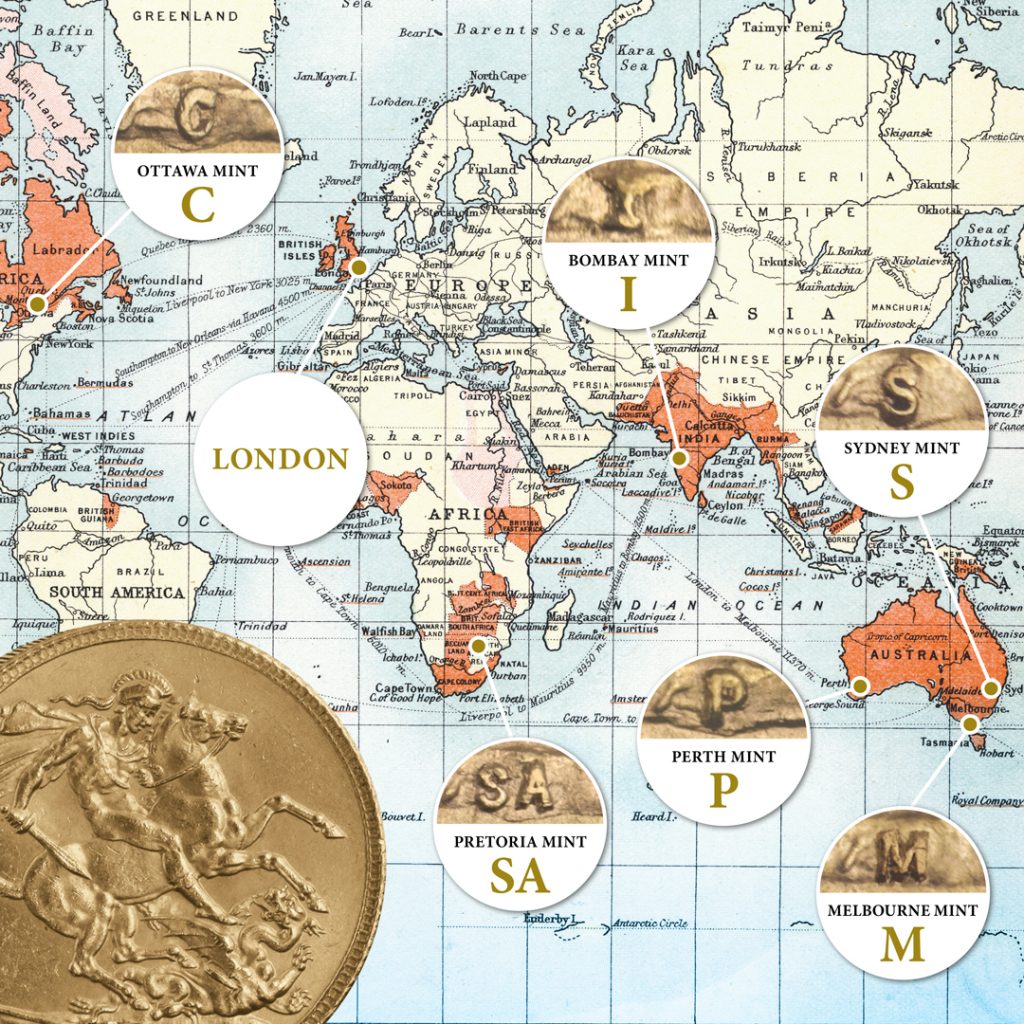
Australian Branch Mints
Australia became a focal point for branch mint sovereigns due to its rich gold deposits discovered during the 19th century. Three main mints operated in Australia:
- Sydney Mint (1855-1926): The first Australian branch mint, it produced sovereigns featuring a unique design with “Sydney Mint” on the reverse until 1870, after which it adopted the standard St. George and the Dragon reverse. These early coins are treasures of history, each telling a story of Australia’s gold rush era. Sovereigns produced in Sydney featured the “S” mintmark.
- Melbourne Mint (1872-1931): Known for its production consistency, the Melbourne Mint produced sovereigns with the “M” mintmark. These coins are prized by collectors for their exquisite craftsmanship and historical significance.
- Perth Mint (1899-1931): The Perth Mint also produced sovereigns marked with a “P”. Its coins stand out for their quality and the rich history of Western Australia’s gold mining legacy.
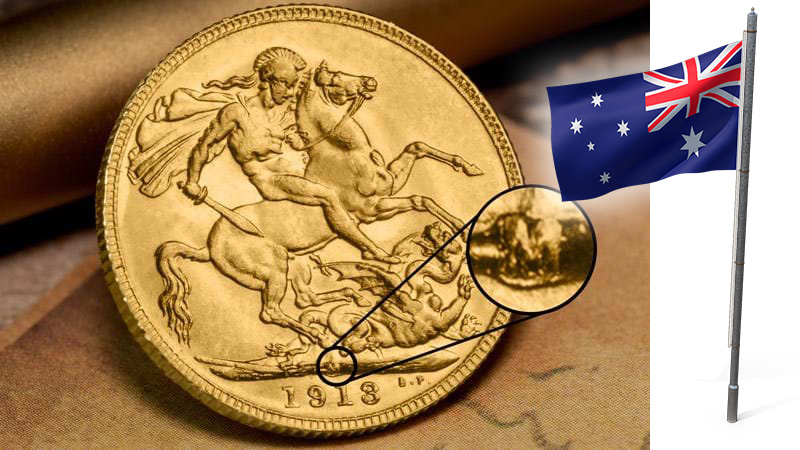
Canadian Branch Mint
The Ottawa Mint, now the Royal Canadian Mint, was established in 1908. Canadian sovereigns, produced between 1908 and 1931, are distinguished by their “O” mintmark. These coins are a testament to Canada’s important role in the British Empire, especially during the First World War. Each sovereign from this era carries with it the story of a nation coming into its own on the global stage.
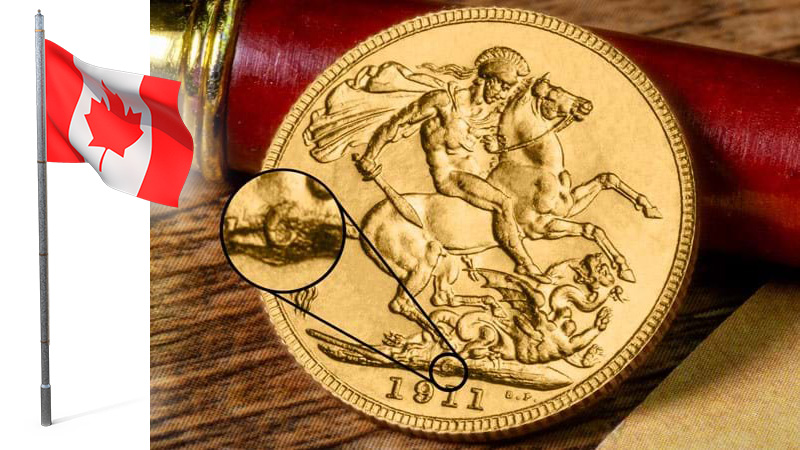
South African Branch Mint
The Pretoria Mint began producing sovereigns in 1923, bearing the “SA” mintmark. These coins are significant due to South Africa’s prominent role in gold production. Sovereigns from the Pretoria Mint circulated widely, symbolizing the region’s economic might and the depth of its natural resources.
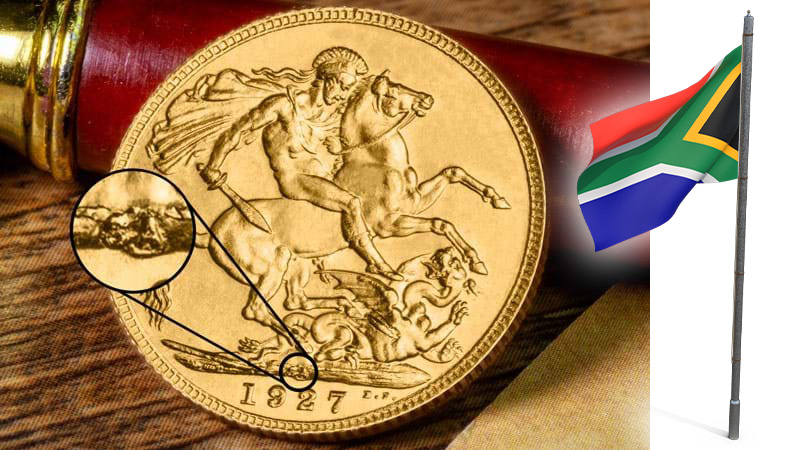
Indian Branch Mint
The Bombay Mint produced sovereigns for a brief period from 1918 to 1919. These coins, marked with an “I” mintmark, are rare and hold a special place in the history of British India. They were minted to address the wartime demand for gold coinage and reflect India’s pivotal role in the British economy. Each coin is a rare gem, representing a fleeting yet crucial moment in history.
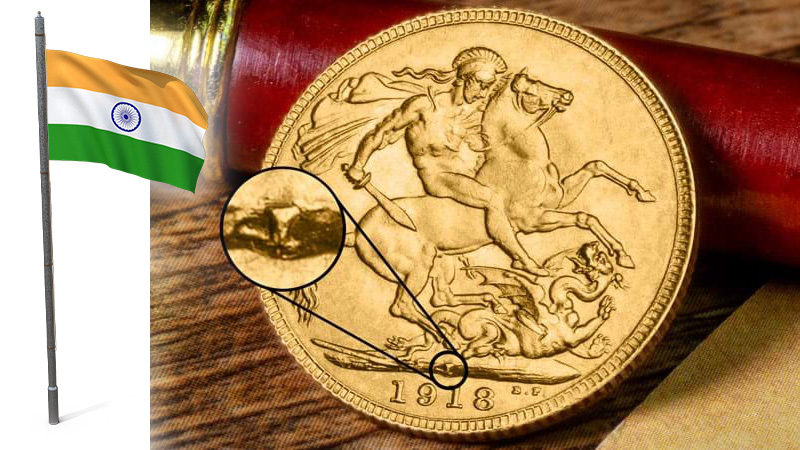
Branch Mint Sovereigns offer a fascinating glimpse into history, connecting the economic dots of the British Empire. From the goldfields of Australia to the financial hubs of Canada, South Africa, and India, these coins represent not just currency but also the economic and cultural exchanges of their time. Collectors and historians alike value these coins for their beauty, rarity, and the stories they tell about an era of global trade and imperial reach.
Dive into the world of Branch Mint Sovereigns with the Complete set of SEVEN ‘Mintmark’ Sovereigns, and let each coin take you on a journey through history. Each Sovereign has been handpicked to complete a set of all seven different mintmarks and all feature the official portrait of George V on the obverse.
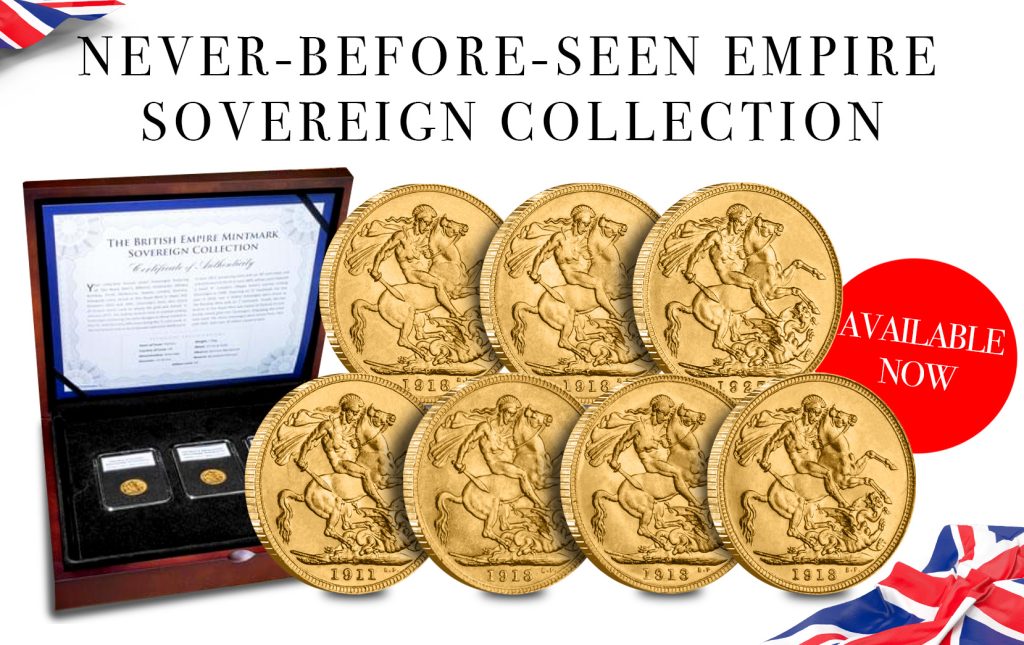
>>> Click here to secure your Never-Before-Seen British Empire Sovereign Collection <<<

